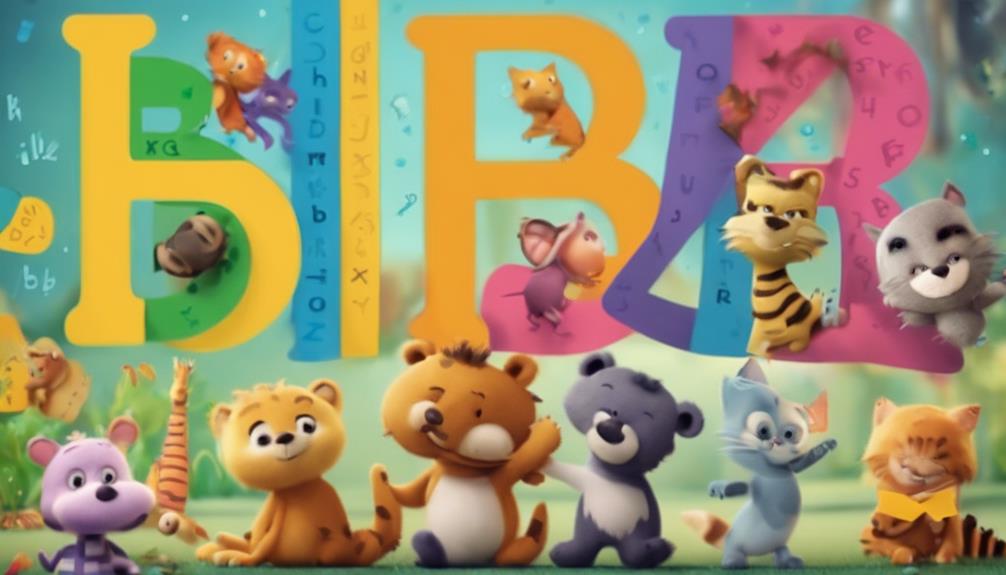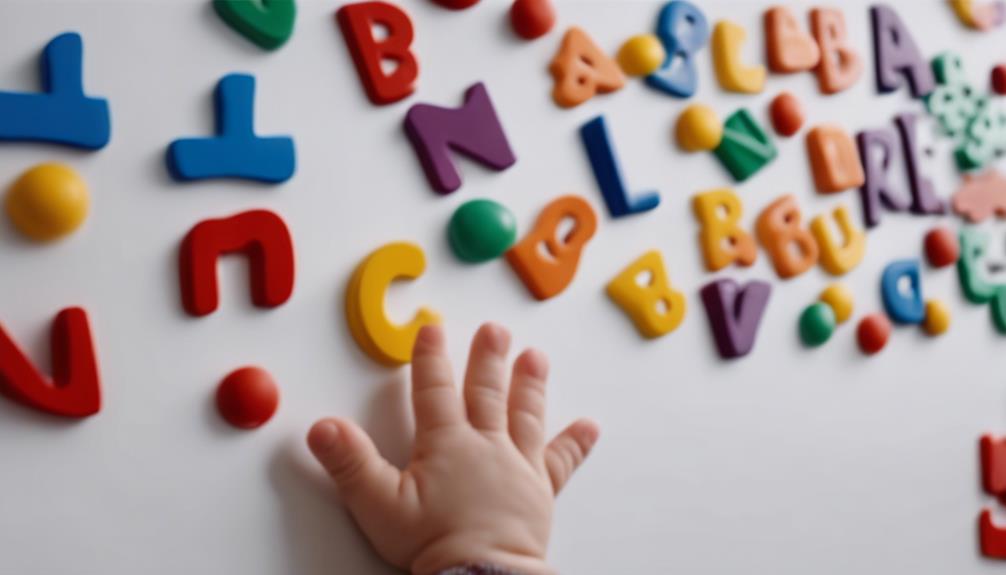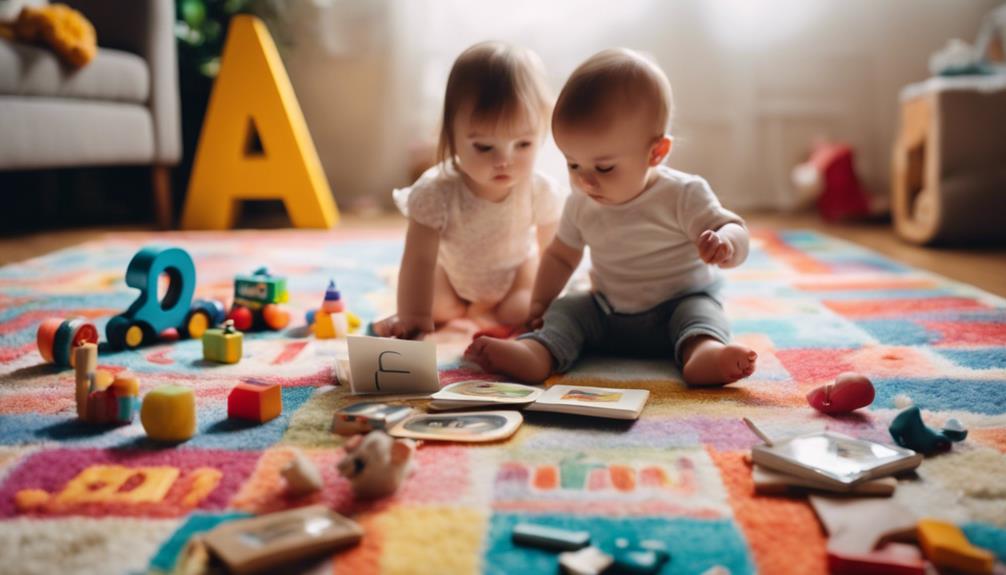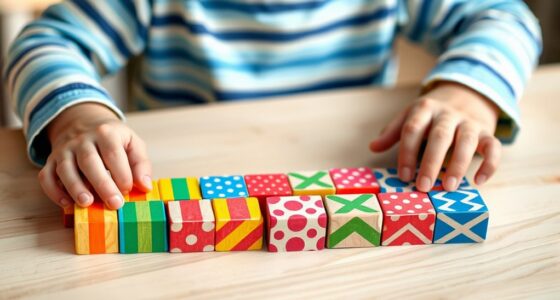To effectively teach your baby the ABCs, consider using interactive alphabet books with bold letters and colorful pictures. Connect letter sounds with memorable words, such as ‘cat’ for ‘C’. Engage in hands-on learning with magnetic letters to improve fine motor skills. Allow your child to learn one sound at a time to prevent overwhelming them. Consistency is crucial for language development, so make learning enjoyable with ABC songs and interactive activities. By incorporating these methods, you can establish a solid foundation for your baby’s early language skills. There are numerous early learning strategies waiting for you to explore.
Key Takeaways
- Incorporate interactive alphabet books into bedtime routines for positive learning associations.
- Associate memorable words with letter sounds for effective learning and language development.
- Engage in hands-on learning with magnetic letters to develop fine motor skills and sensory play.
- Teach easily pronounceable letter sounds associated with memorable words at your child's pace.
- Maintain consistency in teaching ABCs through fun activities, visual aids, songs, and rhymes for enjoyable learning.
Fun Alphabet Books to Read
Explore a variety of fun alphabet books with bold letters and colorful pictures to engage your baby in early learning. These books aren't only visually appealing but also play an important role in introducing your little one to the alphabet.
Incorporating alphabet books into bedtime routines can create a positive association with learning and help in letter recognition.
When choosing alphabet books for your baby, opt for ones that feature both uppercase and lowercase letters. This exposure to different letter forms can aid in strengthening letter recognition skills.
Interactive alphabet books that allow your baby to touch, feel, and explore the letters can make learning the alphabet a playful experience.
Colorful pictures in alphabet books can capture your baby's attention and make learning more enjoyable. By focusing on one letter at a time, these books help babies understand and remember the letters better.
Letter Sounds With Memorable Words

Incorporate memorable words to associate with letter sounds, aiding your baby in connecting sounds to their corresponding letters effectively. By introducing familiar words such as 'cat' for the letter 'C', you provide your baby with a tangible connection between the sound and its written representation in the alphabet. This technique not only enhances memory retention but also lays a solid foundation for your baby's language development.
When babies can connect the sounds they hear with words they already know, the concept of letter sounds becomes more accessible and engaging. This method creates a playful learning environment, making the process enjoyable for your little one.
As they begin to recognize and associate sounds with specific letters, their linguistic skills will gradually improve. Remember, the goal is to make learning fun and interactive, fostering a love for language from an early age.
Tactile Learning With Magnetic Letters

Engage your baby in hands-on learning with magnetic letters to enhance their exploration of alphabet shapes and sounds.
Tactile learning with magnetic letters is a fantastic way to develop your baby's fine motor skills. By manipulating the magnetic letters, your baby can improve their hand-eye coordination and strengthen their fingers. Additionally, the sensory play aspect of feeling the textures of the magnetic letters and sticking them onto surfaces can stimulate your baby's senses, making learning more engaging.
Magnetic letters offer a unique kinesthetic learning experience that can boost alphabet recognition and retention. Placing the magnetic letters on a cookie tin or magnetic board creates an interactive learning environment that can captivate your baby's attention.
According to early childhood education expert Dr. Smith, "Hands-on exploration with magnetic letters not only helps babies recognize alphabet shapes but also encourages active participation in the learning process." Embrace this interactive learning tool to make alphabet learning fun and effective for your baby.
Child-Led Letter Sound Introductions

Start by introducing letter sounds that your child can easily make, like 'mmm' for the letter M or 'sss' for the letter S. When teaching letter sounds, associate each sound with a memorable word or object to enhance learning.
Focus on teaching one new letter sound at a time to avoid overwhelming your child. Keep the process child-led by observing your baby's engagement with different letters and following their interest.
To further enhance your child's learning experience, remember to progress at their pace. Emphasize consistency in practicing and reinforcing letter sounds to guarantee effective retention. By making the learning experience engaging and tailored to your child's preferences, you can create a more impactful and memorable learning environment.
- Teach letter sounds easily pronounceable by your child.
- Associate each sound with a memorable word or object.
- Focus on one new letter sound at a time.
- Make the learning process child-led to maintain engagement.
Consistent and Enjoyable Learning Approach

Consistency in teaching ABCs to your baby is crucial for establishing a strong foundation for language development.
When it comes to teaching your kids the alphabet, incorporating fun and interactive activities is essential to keeping them engaged and enhancing retention.
Utilizing visual aids such as flashcards and magnetic letters can help reinforce letter recognition and sounds in a more hands-on way.
Introducing ABC songs and rhymes into your daily routines can make learning enjoyable and memorable for your little ones.
Frequently Asked Questions
How to Start Teaching Baby Abc?
To start teaching your baby ABC, begin with simple and engaging activities like using ASL signs and magnetic letters. Introduce one sound at a time, making it fun and gradual. Let your child lead the way for enjoyable learning.
How Early Can Babies Learn Abc?
Babies can start learning the ABCs as early as 6-12 months through exposure to letters, sounds, and visual cues. By 18 months, some toddlers may identify a few letters. Toddlers around age 2 begin recognizing letters.
How to Teach ABC to Kindergarten?
When teaching ABC to kindergarteners, blend fun with learning. Use songs, games, and interactive books. Practice daily for letter recognition. Make it hands-on with puzzles and matching games. Explore online tools and toys to reinforce skills.
How Do I Teach My Child ABC Order?
To teach your child ABC order, start with the basics. Introduce the first few letters, use visuals like charts or books, engage in fun activities, practice with puzzles or blocks, and reinforce through repetition.
Conclusion
To sum up, teaching your baby the ABCs early on can establish a strong foundation for their future learning. By incorporating fun alphabet books, memorable words, tactile learning, and child-led introductions, you can make the process enjoyable and effective.
Consistency is key in helping your baby master the alphabet. Remember, the journey to literacy may seem challenging, but with patience and perseverance, your little one will soon be a pro at reciting the ABCs with ease.










